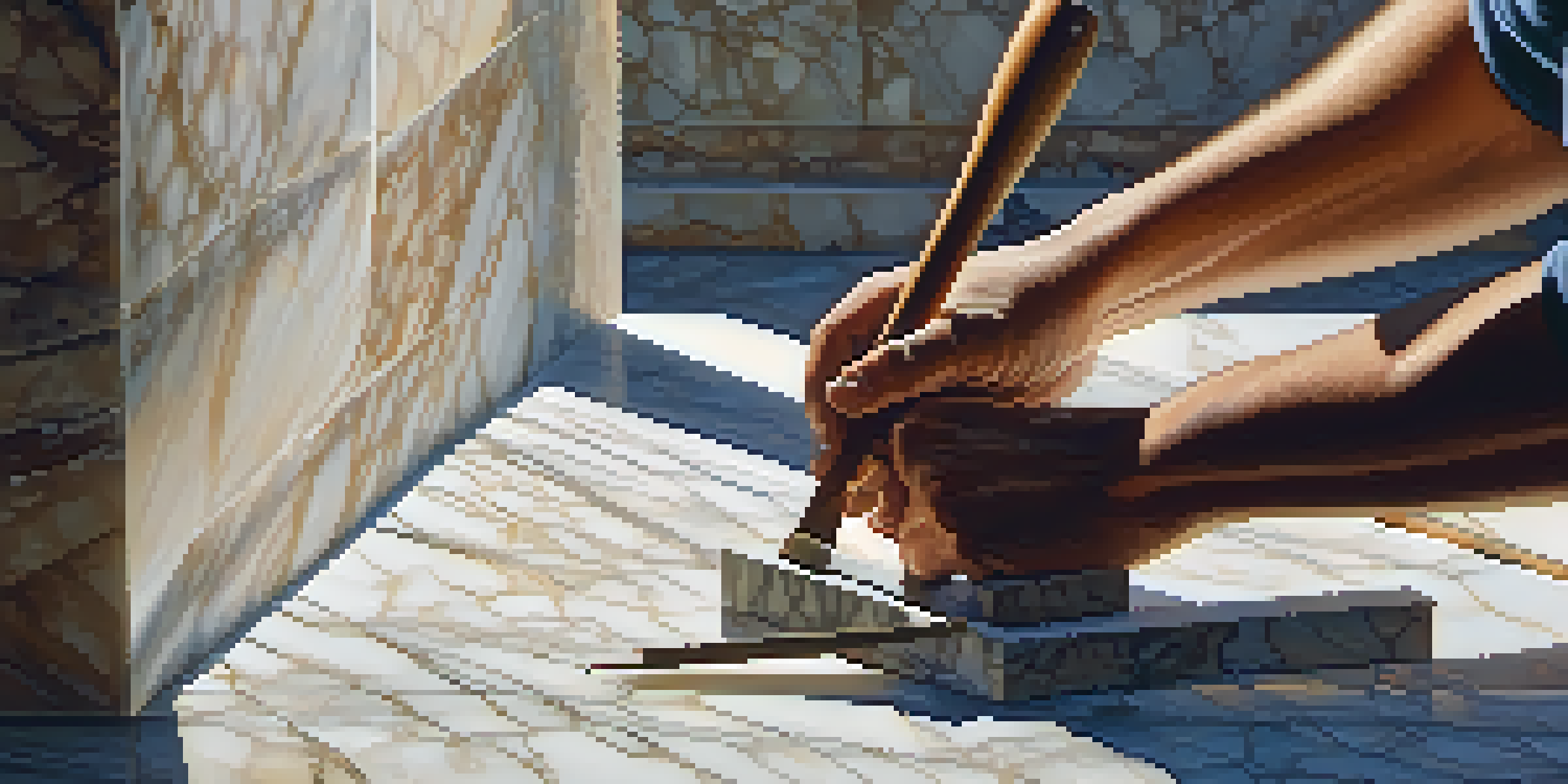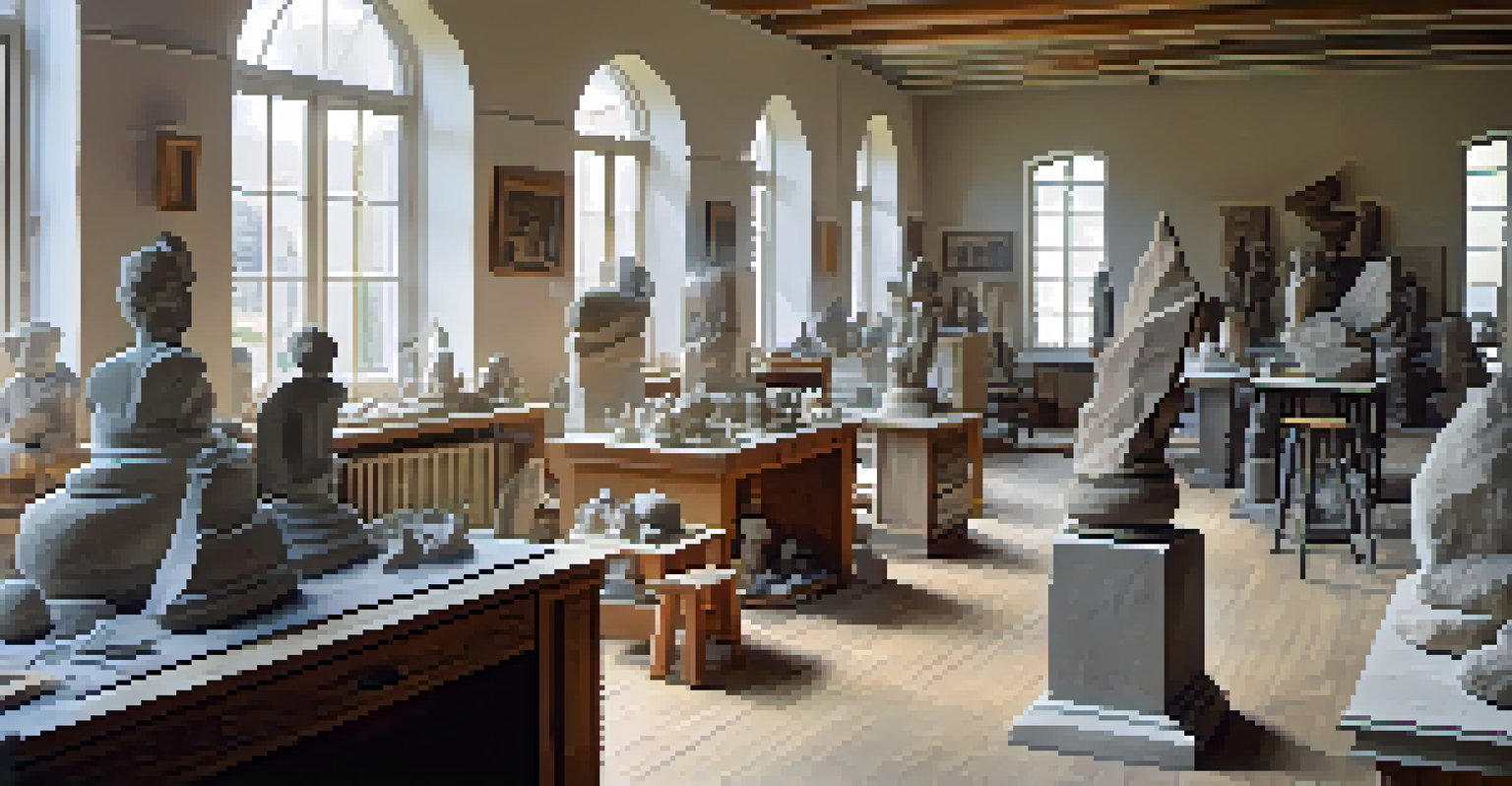The Evolution of Carved Stone Techniques in Architecture

Understanding Carved Stone: A Historical Overview
Carved stone has been a fundamental element of architecture since ancient times, serving both functional and aesthetic purposes. From the majestic pyramids of Egypt to the intricate temples of Greece, stone carving has played a pivotal role in shaping our built environment. The techniques used by early civilizations laid the groundwork for future architectural innovations, showcasing the artistry and skill of their craftsmen.
Architecture is the learned game, correct and magnificent, of forms assembled in the light.
In these early days, artisans relied on simple tools and techniques to shape stone, often using chisels and hammers made from harder materials. This labor-intensive process required immense physical strength and a keen understanding of the stone's properties. As civilizations advanced, so did the tools and techniques, enabling more intricate designs and larger structures that could withstand the test of time.
The significance of stone carving goes beyond mere construction; it reflects cultural values, religious beliefs, and social hierarchies. For instance, the ornate carvings found in Gothic cathedrals not only served to beautify but also conveyed biblical stories to a largely illiterate populace. This intertwining of art and function established a legacy that continues to influence contemporary architecture.
Ancient Techniques: The Roots of Stone Carving
The origins of stone carving can be traced back to prehistoric times, where early humans utilized rudimentary tools to create basic shapes. These initial attempts at carving often served practical purposes, such as creating tools or simple shelters. Over time, as societies evolved, so did their approach to stone, moving from utility to artistry.

In ancient Egypt, the art of stone carving reached new heights with techniques like quarrying and polishing, allowing artisans to create monumental structures such as the Sphinx and pyramids. They developed methods to transport massive stone blocks from quarries to construction sites, showcasing their ability to manipulate their environment. These advancements in technique not only enabled grand architectural feats but also left a lasting imprint on subsequent civilizations.
Historical Importance of Carved Stone
Carved stone has been integral to architecture for centuries, reflecting cultural values and artistic expression across civilizations.
Meanwhile, in Mesopotamia, the use of clay tablets and cylinder seals demonstrated early forms of engraving. These artifacts provide insight into the significance of carved stone in record-keeping and storytelling. The transition from functional to decorative carving highlights the evolving relationship between humans and their built environment, setting the stage for later architectural developments.
Classical Influence: Greek and Roman Innovations
The Greeks and Romans took stone carving to unprecedented levels, introducing refined techniques and styles that continue to influence architecture today. The Greeks mastered the art of proportion and symmetry, exemplified in structures like the Parthenon, where every detail was meticulously carved to achieve aesthetic perfection. Their use of columns, friezes, and pediments added a sense of grandeur that resonated through the ages.
The details are not the details. They make the design.
Roman architects, on the other hand, embraced innovation by incorporating arches and vaults into their designs, which allowed for larger and more complex structures. They utilized a technique known as 'opus caementicium' (Roman concrete), often combined with stone facing, to enhance durability and expand architectural possibilities. The synergy of stone carving and engineering principles marked a significant evolution in architectural design.
These classical techniques not only advanced the art of stone carving but also influenced the architectural styles of future generations. The revival of classical forms during the Renaissance further solidified the importance of carved stone in architecture, as artists and architects sought to emulate the grandeur of ancient civilizations. This enduring legacy is a testament to the timeless appeal of stone as a building material.
Medieval Mastery: Gothic Architecture and Stone Carving
The Middle Ages ushered in a new era of stone carving, particularly evident in the Gothic architectural style. Characterized by pointed arches, ribbed vaults, and flying buttresses, Gothic structures like cathedrals became showcases for intricate stone carvings. These elaborate designs often depicted biblical scenes and figures, serving both decorative and educational purposes.
Artisans of this period honed their skills in relief carving, creating detailed sculptures that adorned facades and interiors. The use of limestone and marble allowed for a range of textures and finishes, enhancing the visual impact of these structures. The craftsmanship involved in creating these ornate details required not only skill but also a deep understanding of both artistic and structural principles.
Innovations in Stone Carving Techniques
Advancements in technology have transformed traditional stone carving, allowing for greater precision and creativity in modern architecture.
Gothic architecture's emphasis on verticality and light transformed how spaces were perceived, with stone carvings playing a crucial role in guiding the viewer's eye upward. This interplay of light and shadow created a dynamic experience, making the carved stone an integral part of the architectural narrative. The legacy of Gothic stone carving continues to inspire modern architects and artists alike.
Renaissance Revival: Rediscovering Classical Techniques
The Renaissance marked a significant turning point in the evolution of carved stone techniques as artists and architects sought to revive the ideals of classical antiquity. This period celebrated humanism, and stone carving became a means of expressing individual creativity and innovation. The meticulous study of ancient texts and ruins inspired a return to proportion, symmetry, and harmony in architectural design.
Prominent figures like Michelangelo and Bernini pushed the boundaries of stone carving by creating sculptures that conveyed emotion and movement. Their work demonstrated an unparalleled mastery of form, utilizing techniques such as chiaroscuro to create depth and drama. The Renaissance not only saw advancements in carving techniques but also a greater appreciation for the materiality of stone itself, elevating it to new artistic heights.
As architects began to incorporate these refined techniques into their structures, the built environment transformed once again. The revival of column orders and decorative elements not only paid homage to the past but also paved the way for the Baroque and Neoclassical movements. This period solidified the role of carved stone as a medium for artistic expression in architecture.
Modern Approaches: Innovations in Stone Carving
As we moved into the 19th and 20th centuries, the advent of new technologies began to reshape traditional stone carving techniques. The introduction of machinery, such as the stone saw and pneumatic tools, allowed artisans to achieve greater precision and efficiency. This shift made it possible to create larger and more complex sculptures while also reducing the labor-intensive nature of the craft.
Contemporary artists and architects have embraced these advancements, often blending traditional techniques with modern materials and designs. The use of computer-aided design (CAD) and digital fabrication has revolutionized the way stone is carved, enabling intricate patterns and textures that were once unimaginable. This fusion of old and new reflects a dynamic evolution in the craft, allowing for endless creative possibilities.
Cultural Diversity in Stone Carving
Different cultures contribute unique stone carving techniques, enriching the architectural narrative and highlighting its global significance.
Moreover, the resurgence of interest in sustainable architecture has prompted a reevaluation of stone as a building material. Its durability and natural beauty make it an attractive choice for modern constructions. As we look to the future, the evolution of carved stone techniques continues to be a testament to the enduring relationship between art, architecture, and technology.
Cultural Significance: Stone Carving in Global Perspectives
The art of stone carving transcends geographical boundaries, with diverse cultures contributing unique techniques and styles. In India, for instance, the intricate carvings of temples like those at Khajuraho reflect a deep spiritual connection and a rich cultural heritage. These carvings serve as a window into the beliefs and practices of the time, showcasing the skill and dedication of the artisans.
Similarly, in Asia, cultures like the Chinese have a long history of stone carving, using it to create everything from sculptures to architectural elements. The delicate craftsmanship seen in traditional Chinese stone carvings often illustrates philosophical concepts and natural elements, emphasizing harmony with nature. This cultural significance adds layers of meaning to the carved stone, making it an essential aspect of architectural identity.

As globalization continues to influence architecture, the blending of different stone carving techniques presents exciting opportunities for innovation. Contemporary architects often draw inspiration from various cultural practices, creating structures that resonate on a global scale. This interplay of cultures enriches the narrative of carved stone, highlighting its universal appeal and relevance in today's architectural landscape.
The Future of Carved Stone: Challenges and Opportunities
Looking ahead, the future of carved stone techniques faces both challenges and opportunities. As the construction industry increasingly prioritizes efficiency and cost-effectiveness, traditional stone carving may be at risk of being overshadowed by mass-produced alternatives. However, this challenge also presents an opportunity for artisans to differentiate their work through craftsmanship and unique design.
Sustainability is another critical factor influencing the future of carved stone. As awareness of environmental impacts grows, there is a push for using locally sourced materials and eco-friendly practices in stone carving. This shift not only supports sustainable practices but also fosters a deeper connection between the built environment and the natural world.
Ultimately, the evolution of carved stone techniques will continue to be shaped by cultural shifts, technological advancements, and environmental considerations. As architects and artists navigate these changes, the enduring beauty and significance of carved stone in architecture will likely persist, inspiring future generations to create meaningful and lasting structures.